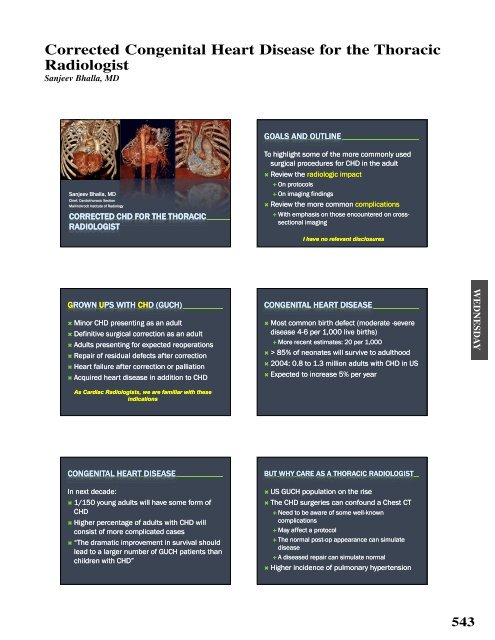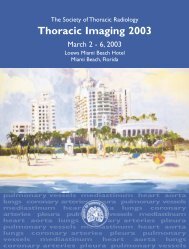View Presentation - Society of Thoracic Radiology
View Presentation - Society of Thoracic Radiology
View Presentation - Society of Thoracic Radiology
Create successful ePaper yourself
Turn your PDF publications into a flip-book with our unique Google optimized e-Paper software.
Corrected Congenital Heart Disease for the <strong>Thoracic</strong><br />
Radiologist<br />
Sanjeev Bhalla, MD<br />
Sanjeev Bhalla, MD<br />
Chief, Cardiothoracic Section<br />
Mallinckrodt Institute <strong>of</strong> <strong>Radiology</strong><br />
CORRECTED CHD FOR THE THORACIC<br />
RADIOLOGIST<br />
GROWN ROWN UPS PS WITH CH CHD D (GUCH)<br />
Minor CHD presenting as an adult<br />
Definitive surgical correction as an adult<br />
Adults presenting for expected reoperations<br />
Repair <strong>of</strong> residual defects after correction<br />
Heart failure after correction or palliation<br />
Acquired heart disease in addition to CHD<br />
As Cardiac Radiologists, we are familiar with these<br />
indications<br />
CONGENITAL HEART DISEASE<br />
In next decade:<br />
1/150 young adults will have some form <strong>of</strong><br />
CHD<br />
High Higher percentage t g <strong>of</strong> f adults d lt with ith CHD CHD will ill<br />
consist <strong>of</strong> more complicated cases<br />
“The dramatic improvement in survival should<br />
lead to a larger number <strong>of</strong> GUCH patients than<br />
children with CHD”<br />
GOALS AND OUTLINE<br />
To highlight some <strong>of</strong> the more commonly used<br />
surgical procedures for CHD in the adult<br />
Review the radiologic impact<br />
On On protocols<br />
protocols<br />
On imaging findings<br />
Review the more common complications<br />
With emphasis on those encountered on cross-<br />
sectional imaging<br />
I have no relevant disclosures<br />
CONGENITAL HEART DISEASE<br />
Most common birth defect (moderate -severe severe<br />
disease 4-6 4 6 per 1,000 live births)<br />
More recent estimates: 20 per 1,000<br />
> > 85% <strong>of</strong> neonates will will survive survive to to adulthood<br />
adulthood<br />
2004: 0.8 to 1.3 million adults with CHD in US<br />
Expected to increase 5% per year<br />
BUT WHY CARE AS A THORACIC RADIOLOGIST<br />
US GUCH population on the rise<br />
The CHD surgeries can confound a Chest CT<br />
Need to be aware <strong>of</strong> some well-known well known<br />
complications<br />
May affect a protocol<br />
The normal post-op post op appearance can simulate<br />
disease<br />
A diseased repair can simulate normal<br />
Higher incidence <strong>of</strong> pulmonary hypertension<br />
543<br />
WEDNESDAY
WEDNESDAY<br />
544<br />
CONDITIONS THAT MAY PRESENT IN<br />
ADULTHOOD<br />
Ebstein Anomaly<br />
Bicuspid aortic valve<br />
ASD (secundum) and other septal defects<br />
VSDs most common but >85% heal spontaneously<br />
Anomalous pulmonary venous return<br />
Coronary artery anomalies<br />
Aortic coarctation<br />
Silent Ductus (PDA)<br />
For sake <strong>of</strong> time, let us skip these lesions.<br />
TETRALOGY OF FALLOT (TOF)<br />
Long Long-term term survival is great (>89% at 30 yrs)<br />
Definitive repair with homograft and VSD<br />
closure is treatment <strong>of</strong> choice<br />
ADULTS WITH REPAIRED CHD<br />
Tetralogy <strong>of</strong> Fallot<br />
Blalock Taussig<br />
Univentricular physiology<br />
Gl Glenn Gl<br />
Fontan and Modifications<br />
Congenital valvular<br />
Ross<br />
Repaired TGA<br />
Baffles<br />
Jatene<br />
TETRALOGY OF FALLOT (TOF)<br />
Radiologic Impact<br />
Dilated aortic root (unkown ( unkown, , ?TGF-Beta) ?TGF Beta)<br />
Peripheral pulmonic stenoses<br />
Coronaries have a clockwise orientation
TOF<br />
Patients may undergo<br />
palliation with Blalock Blalock-Taussig Taussig<br />
(BT) shunt<br />
Subclavian Subclavian Artery Artery to to PA<br />
PA<br />
Contralateral side <strong>of</strong> the Aortic<br />
Arch<br />
Classic uses proximal SCA;<br />
now use graft material<br />
TOF<br />
<strong>Radiology</strong> Impact:<br />
Unilateral, ipsilateral rib notching (Classic)<br />
Vessel in paratracheal region<br />
Complications <strong>of</strong> <strong>of</strong> BT<br />
Thrombosis<br />
Seroma adjacent to graft<br />
Occluded ipsilateral PA or stenotic PA<br />
Enlarged bronchial arteries (MAPCAS)<br />
545<br />
WEDNESDAY
WEDNESDAY<br />
546<br />
UNIVENTRICLE HEART<br />
The goal is to let the lungs (pulmonary arteries)<br />
fill passively and convert the heart to a<br />
systemic ventricle.<br />
Glenn Glenn (SVC to PA)<br />
Fontan (RA to PA)<br />
Modified Fontan is the standard<br />
GLENN<br />
Radiologic Impact<br />
Altered flow dynamics: Side with shunt opacifies<br />
early with arm injection<br />
Complications<br />
Pulmonary arteriovenous malformations<br />
FONTAN<br />
Radiologic Impact<br />
Altered flow dynamics:<br />
Depends on the type but classically, left lung opacifies<br />
late (unless leg injection)<br />
Complications<br />
Pulmonary arteriovenous malformations<br />
Big right atrium ( (arrythmias arrythmias)<br />
Thrombus<br />
Hepatomegaly (cirrhosis and possible HCC)<br />
Protein losing enteropathy
OFTEN GLENN AND FONTAN USED TOGETHER<br />
547<br />
WEDNESDAY
WEDNESDAY<br />
548<br />
CAVOPULMONARY SHUNT<br />
Sometimes called modified Fontan<br />
Inferior tunnel may be<br />
Intracardiac or extracardiac<br />
Fenestrated F FFenestrated t t d or not t<br />
Often times imaging is performed to address<br />
the question: is the RV failing or is it a conduit<br />
failure?<br />
CAVOPULMONARY SHUNT<br />
Radiologic Impact:<br />
Altered flow dynamics: right lung opacifies early and<br />
left lung opacifies late<br />
Complications:<br />
Thrombus<br />
Other complications are less common than with<br />
Glenn or Fontan alone<br />
Collateral arteries may be seen with Fontan, Glenn<br />
or Cavopulmonary Shunts<br />
CAVOPULMONARY SHUNT<br />
When there is a fear <strong>of</strong> subaortic obstruction,<br />
the cavopulmonary may be combined with an<br />
outlet procedure: Damus Damus-Kaye Kaye-Stansel Stansel<br />
The DKS is an an anastamosis <strong>of</strong> the proximal PA and<br />
the Aorta<br />
Tricuspid Atresia + TGA<br />
<strong>Radiology</strong> Impact:<br />
The outflow ill have an odd appearance and may<br />
simulate an AA aneurysm
RETIRED CLASSICS<br />
Waterston Waterston-Cooley Cooley<br />
Formerly used for TOF, tricuspid atresia, P Atresia<br />
Ascending Aorta to R PA<br />
Complications: Complications: stenosis stenosis <strong>of</strong> R PA and PH<br />
Potts<br />
Formerly used for TOF, triscuspid atresia, P Atresia<br />
Descending Aorta to L PA<br />
Complications: stenosis <strong>of</strong> LPA and PH<br />
RETIRED CLASSICS<br />
Waterston<br />
Potts<br />
VALVULAR HEART DISEASE<br />
Bicuspid aortic valve is one <strong>of</strong> the more<br />
common CHDs<br />
Congenital AS may undergo Ross Procedure<br />
I In a R Ross, the th native ti P P Valve V l is i used d for f the th A<br />
A<br />
Valve and a cadaveric P valve is used<br />
Great idea!<br />
Bad idea- idea 1 valve disease 2 valve disease<br />
The native aorta becomes dilated and the main<br />
PA is stenotic (does not grow)<br />
549<br />
WEDNESDAY
WEDNESDAY<br />
550<br />
TRANSPOSITION<br />
The definition <strong>of</strong> transposition:<br />
RV gives rise to Aorta<br />
AV valves follow the ventricles<br />
Th The coronary arteries t i f follow ll th the ventricles t i l<br />
In D-TGA, D TGA, the RV communicates with the RA<br />
RA RV Aorta; Aorta; LA LV LV PA<br />
In L-TGA, LTGA,<br />
the RV communicates with the LA<br />
RA LV LV PA; LARV LA RV Aorta<br />
D-TGA TGA<br />
Arterial switch (Jatene) is now the preferred<br />
correction<br />
Radiologic Impact: Classic shape <strong>of</strong> the great<br />
vessels (akin (a to a Dutch hat) t)<br />
Complications [Few]:<br />
D-TGA TGA<br />
Coronary artery kinking in the immediate post post-op op period<br />
Branch pulmonary artery stenoses<br />
Neoaortic root dilitation<br />
Inflow switch (Baffles) were used up until the<br />
late 1980’s. Mustard (Pericardium); Senning<br />
(Atrial tissue)<br />
Radiologic Impact: SVC SVC,IVC IVC are directed to the<br />
left ventricle and the pulmonary veins to the<br />
right ventricle<br />
Complications:<br />
Baffle leaks<br />
Baffle stenoses<br />
Arrythmias requiring pacemakers
THANKS<br />
GUCH patients are on the rise<br />
No longer a pediatric condition<br />
No longer only a Cardiac Imager’s Issue<br />
Many <strong>of</strong> these conditions will affect our<br />
protocols (Glenn, Fontan, Cavopulmonary)<br />
My result in anatomic changes<br />
Associated with extracardiac complications<br />
AVMs<br />
Ascending aortic aneurysms<br />
Cirrhosis<br />
Condition Treatment Potential Complications Radiologic Impact<br />
Tetralogy <strong>of</strong><br />
Fallot<br />
Univentricle<br />
Heart<br />
Congenital<br />
Aortic sten<br />
Homograft repair<br />
Blalock Taussig<br />
(SCA to PA)<br />
Aneurysm and pulmonic<br />
regurgitation<br />
Occlusion<br />
Cavopulmonary Venovenous collaterals<br />
Glenn (SVC to PA) Pulmonary AVMs<br />
Fontan (RA to PA)<br />
Damus Kaye<br />
Stanssel (aortic<br />
obstruction<br />
D-TGA Jatene (switch)<br />
Baffles<br />
Large RA (thrombus)<br />
Cirrhosis<br />
Ross Pulmonic stenosis<br />
Aortic Regurgitation<br />
Rare<br />
Stenoses and leaks<br />
Pulm Stenoses<br />
Rotated Coronaries<br />
Dilated Ascending Aorta<br />
Calcified aneurysm <strong>of</strong> RVOT<br />
Ipsilateral stenoses and<br />
collaterals<br />
Altered flow dynamics<br />
Opacifies ipsilateral lung early<br />
Altered flow (may require<br />
delayed imaging)<br />
May simulate aneurysm or<br />
mediastinal mass<br />
Bicuspid valves may have<br />
dilated aortas<br />
Dutch hat sign<br />
Altered inflow into ventricles<br />
551<br />
WEDNESDAY







